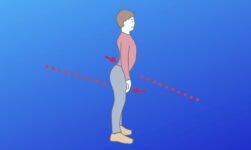
BPPV Vertigo is a type of peripheral vertigo. It affects a person’s ability to maintain their balance, walk in a straight line, or balance themselves properly. BPPV causes people to feel dizzy all of a sudden, experience spinning sensations & false perceptions of their surroundings moving, along with nausea, motion sickness, & headaches.
Experiencing hearing issues like a ringing noise inside the ears(also known as Tinnitus) is also common.
BPPV can bring about mild to severe episodes of dizziness, nausea, & motion sickness in those affected.
The attacks are usually triggered by specific changes in the direction & position of your head. Actions like tipping your head to one side, bending over, rolling over to your side in bed, or suddenly getting up from a sitting position, can all trigger attacks in those that suffer from BPPV Vertigo.
Although BPPV isn’t a serious illness, it can seriously affect your balance & the ability to engage in everyday activities with ease. The constant danger of getting dizzy and falling down can sometimes be too much for people to handle. This can lead to some patients becoming anxious and depressed, creating a twofold problem over the already existing BPPV vertigo.
BPPV symptoms:
BPPV symptoms range across a variety of vestibular disorders. It’s possible for two people with BPPV to have different symptoms. However, there are some symptoms that are common across all BPPV vertigo patients. These include:
- Rapid eye movements, also known as nystagmus
- Headaches, sometimes of migraine intensity
- Sudden spells of dizziness
- Nausea
- Vomiting
- Motion sickness
- Sensations of the surroundings spinning around & moving
- Hearing issues
- tinnitus(a ringing or buzzing sound in the ears)
Fortunately, there are BPPV treatment exercises & BPPV treatment medicines available. This helps improve the patient’s condition enough that they can easily partake in daily life activities & also enjoy a social life.
In this blog, we discuss some of the most commonly recommended BPPV vertigo treatment exercises & BPPV vertigo medicines for quick & effective vertigo treatment.
BPPV Treatment exercises:
BPPV is caused by loose calcium crystals that have accidentally lodged inside the semicircular canal of the inner ear. These crystals normally reside in the middle ear, where they don’t cause problems with the body’s balance, being motion-sensitive. However, since the inner ear maintains the body’s balance & position, these crystals are capable of hindering this aspect of its functioning. Just how these crystals get lodged inside the inner ear in the first place, is also important.
Some of the commonest BPPV Causes include:
- Head injuries
- Ear infections
- Fluid accumulation inside the ear(s)
- Ear surgery
- Whiplash
- Blunt force trauma to the head
Sometimes, BPPV doesn’t really have any distinguishable cause.
BPPV treatment exercises include:
- Canalith Repositioning Maneuvers: The Canalith Repositioning maneuvers help by removing the calcium crystals from the semicircular canal. These exercises consist of specially designed maneuvers that help dislodge the calcium crystals from inside the ear canal & replaces them in their original location inside the middle ear. Some of the most popular canalith repositioning maneuvers are the Epley Maneuver, the Brandt-Daroff exercises, & the Semont-Foster maneuver. All of these exercises help reposition the displaced calcium crystals back into the middle ear where they can’t interfere with the functioning of the inner ear. These exercises are usually only performed by a doctor, unless they think it is fit for you to do these at home by yourself. They might trigger BPPV attacks in patients, so it’s best to always bring someone along when you’re going to have your session with a vertigo specialist. All of these exercises are usually performed for a set amount of time in a certain number of sets until the BPPV symptoms are gone. If your symptoms don’t improve even after a considerable time or your condition gets worse, stop the exercises & talk to your doctor.
- BPPV medicines: Aside from BPPV Vertigo exercises, your doctor may also prescribe you some BPPV vertigo medicines. These medicines are known to reduce the intensity & frequency of BPPV attacks, as well as give you relief from some BPPV vertigo symptoms. Each medicine has different properties, hence you must only take a BPPV medicine after proper consultation with your doctor.
Some of the most commonly prescribed BPPV Vertigo medicines are:
–Meclizine, which also comes by the names of Antivert, Bonine, Dramamine II, & D-Vert. It is an antihistamine which blocks the action of certain chemical messengers involved in making a person feel dizzy, nauseous, & faint.
-Diazepam, which also goes by the name Valium. It helps calm the fired up neurons in the vestibular nerve that is responsible for carrying balance-related signals from the inner ear to the brain.
-Dimenhydrinate, also known as Dramamine. Another Antihistamine that reduces dizziness & nausea in a BPPV Vertigo patient.
-Promethazine, also known as Phenergan. It belongs to the category of Medicine called phenothiazines. They help reduce nausea & vomiting in a BPPV patient.
-Scopolamine, also known as Scopace
–Antibiotics & antiviral medicines might also be given in case the patient has a bacterial or a viral infection.
In this case, your doctor will also tell you to rest & drink an adequate amount of fluids.
-Steroids like prednisone also help reduce inflammation if that is causing vertigo-like symptoms in a patient.
- Home remedies: certain home remedies like taking Ginkgo Biloba supplements, Vitamin D supplements, Vitamin B12 supplements, eating foods rich in foliage, green leafy vegetables, & getting good sleep are all important for BPPV treatment. Dehydration is also a cause of vertigo-like symptoms in some people. Drinking adequate water & intaking lots of fluids throughout the day is also an important BPPV Vertigo treatment method.
- Surgical Methods: Surgery might also be needed in some cases where patients don’t respond very well to other traditional BPPV Vertigo treatment methods. Also, it is possible that some calcium crystals might dislodge into the semicircular canal again, even after the canalith repositioning exercises remove them. In such a case, it becomes necessary to treat the condition with surgery to provide a more permanent solution.
It is alo possible for BPPV Vertigo to go away on its own in some time, without the need for any medical interventions. However, it is important to keep checking for BPPV symptoms & visit a vertigo specialist as soon as they reappear.
In most cases, BPPV Vertigo is completely treatable, without any relapses. However, if a patient develops BPPV due to a head injury or a whiplash injury, it’s likely that their BPPV Vertigo symptoms will come back even after proper BPPV Vertigo treatment.
It might happen suddenly, or might take some time. However, surgical options and a proper BPPV treatment plan can greatly reduce the incidence of such recurrences.





